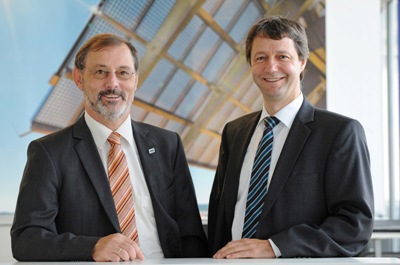Oct 11 2012
Climate change, dwindling fossil resources, burgeoning global population: if we intend to have a future with a reliable, environmentally-sound energy supply, we need new solutions now.
 Dr. Andreas Bett (left) of Fraunhofer ISE with Hansjörg Lerchenmüller (right) of the Soitec Company received the German Environmental Award 2012. (© Fraunhofer ISE/Soitec)
Dr. Andreas Bett (left) of Fraunhofer ISE with Hansjörg Lerchenmüller (right) of the Soitec Company received the German Environmental Award 2012. (© Fraunhofer ISE/Soitec)
The sun delivers a boundless supply of clean power, so therefore it can help cover the demand for energy. In order to exploit solar energy's potential more effectively photovoltaic technology has to become even more efficient and more affordable. This problem is addressed by the work of Andreas Bett of the Fraunhofer Institute for Solar Energy Systems ISE in Freiburg and Hansjörg Lerchenmüller, General Manager of Soitec solar GmbH :They developed concentrator photovoltaic systems based on multijunction solar cells, and deployed them for industrial use. This system is capable of converting almost twice the incident sunlight into electricity as compared to conventional silicon-based systems. Both experts in photovoltaics will be honored with the 2012 DBU German Environmental Award for this technology. The award, which comes with a EUR 500,000 endowment, is one of the most significant environmental prizes in Europe. This year, the award goes to two projects. In addition to the concentrator photovoltaics experts, Günter Cramer – co-founder and head of the Supervisory Board of SMA Solar Technology AG in Kassel – is being recognized for engineering the photovoltaic inverter, a product which is now a global market leader.
Doubled power output
Yet how does one manage to double power output using multi-junction solar cells? Conventional solar cells made of silicon are unable to convert the entire solar spectrum into power. The prizewinners therefore used an array of different semi-conducting materials. They stacked layers of gallium indium phosphide, gallium indium arsenide and germanium in layers, which allows them to nearly completely capture the sun's energy. Three years ago, the research team under Andreas Bett thus achieved a degree of efficiency equal to 41.1 percent – a world record at the time.
Bundled sunlight
It costs a lot of time and money to produce triple-junction solar cells. So, to affordably produce multi-junction solar cells, the researchers resorted to a trick. They put a lens in front of each cell, which then bundles the sunlight 500-fold. The tiny semiconductors, measuring a mere three millimeters in diameter, are now sufficient enough to catch focused beams of light. "The use of low-cost focusing optics fosters an economical use of otherwise expensive semiconducting materials. Depending on the concentration factor, you only need one five-hundredth to one one-thousandth of the semiconducting material – but you can still elevate the efficiency of the solar cell," explains Dr. Andreas Bett, division director of "Materials – Solar Cells and Technologies" and deputy director of Fraunhofer ISE.
Increased efficiency of multi-junction solar cells
Together with his colleagues at Fraunhofer ISE, Bett succeeded in improving the efficiency of multi-junction solar cells and in optimizing the development of the concentrator photovoltaic module. The Concentrix Company was founded in 2005 in Freiburg to facilitate its industrial application. Four years later, Soitec acquired the spin-off company. Hansjörg Lerchenmüller, a former comrade-in-arms at Fraunhofer ISE, has advanced the commercialization and internationalization even further, ever since the spin-off. Soitec successfully brought the design of the concentrator photovoltaic module to serial production, and today it is the global market leader. Industrially manufactured modules have a 30 percent degree of efficiency: a value that Lerchenmüller and Bett intend to increase over the coming years.
The concentrator photovoltaic modules require direct solar radiation. They are therefore particularly suited for use in solar parks in South Europe, North Africa, the American Southwest or the Middle East. The Soitec Company's solar power plants – which have a total capacity in excess of 10 megawatts – are already operating in 14 different countries.